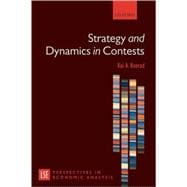
Note: Supplemental materials are not guaranteed with Rental or Used book purchases.
Purchase Benefits
Looking to rent a book? Rent Strategy and Dynamics in Contests [ISBN: 9780199549603] for the semester, quarter, and short term or search our site for other textbooks by Konrad, Kai A.. Renting a textbook can save you up to 90% from the cost of buying.
| Preface and Acknowledgements | |
| An Introduction to Contests | |
| A definition | |
| Examples | |
| The structure of the book | |
| Types of Contests | |
| The first-price all-pay auction | |
| Additive noise | |
| The Tullock contest | |
| Experimental evidence | |
| Evolutionary success | |
| Summary | |
| Timing and Participation | |
| Endogenous timing | |
| Voluntary participation | |
| Exclusion | |
| Delegation | |
| Summary | |
| Cost and prize structure | |
| Choice of cost | |
| The structure of prizes | |
| Endogenous prizes | |
| Summary | |
| Externalities | |
| State lotteries and financing public goods | |
| A loser's preference about who wins | |
| Personnel economics and sabotage | |
| Information externalities and campaigning | |
| Inter-group contests and free riding | |
| Conclusions | |
| Nested contests | |
| Exogenous sharing rules | |
| The choice of sharing rules | |
| Intra-group conflict | |
| A strategy of analysis of nested contests | |
| Alliances | |
| The alliance formation puzzle | |
| Solutions to the alliance formation puzzle | |
| Summary | |
| Dynamic battles | |
| The elimination tournament | |
| The race | |
| The tug-of-war | |
| Iterating incumbency fights | |
| Endogenous fighting | |
| Summary: the discouragement effect | |
| Conclusions | |
| Table of Contents provided by Publisher. All Rights Reserved. |
The New copy of this book will include any supplemental materials advertised. Please check the title of the book to determine if it should include any access cards, study guides, lab manuals, CDs, etc.
The Used, Rental and eBook copies of this book are not guaranteed to include any supplemental materials. Typically, only the book itself is included. This is true even if the title states it includes any access cards, study guides, lab manuals, CDs, etc.